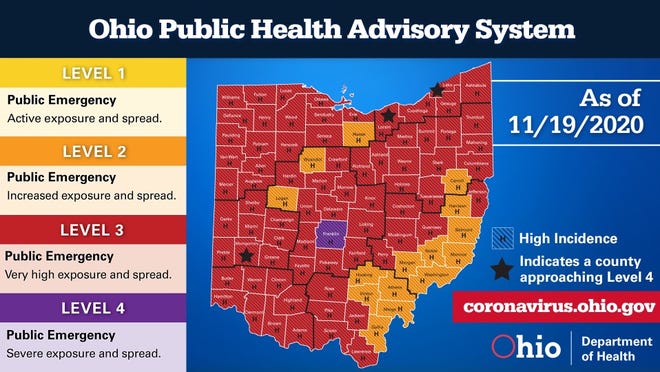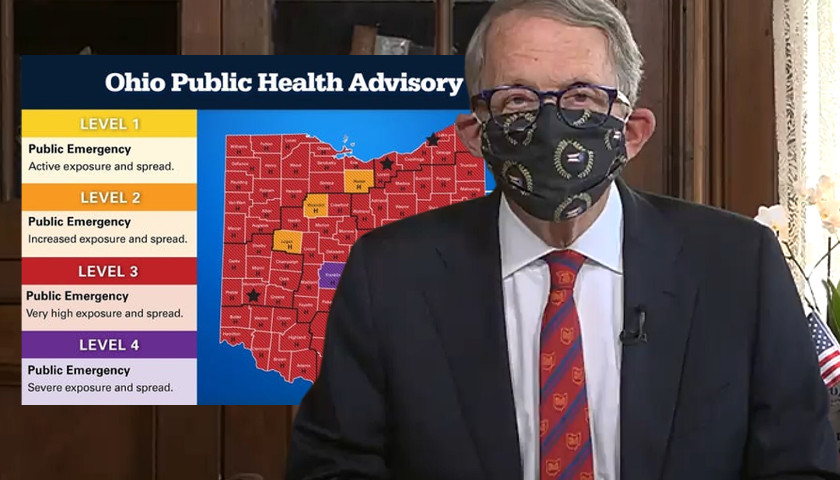The Ohio Public Health Advisory System (OPHAS) is the color-coded map that assigns a health emergency threat level to each of Ohio’s 88 counties based on seven indicators.
 Those seven alert indicators are listed below, links are embedded for the first six indicators that will direct to a story The Ohio Star has reported. The seventh indicator is the topic of this report.
Those seven alert indicators are listed below, links are embedded for the first six indicators that will direct to a story The Ohio Star has reported. The seventh indicator is the topic of this report.
- New cases per capita – triggered if greater than 50 cases per 100,000 residents over the last two weeks.
- Sustained increase in new cases – triggered if increasing trend of at least 5 consecutive days in overall cases by onset date over the last three weeks.
- Proportion of cases not in congregate setting – triggered if proportion of cases that are not in a congregate setting goes over 50% in at least one of the last three weeks.
- Sustained increase in Emergency Department (ED) visits for COVID-like illness – triggered if increasing trend of at least five consecutive days in the number of visits to the emergency department with COVID-like illness or diagnosis over the last three weeks.
- Sustained increase in outpatient visits for COVID-like illness – triggered if increasing trend of at least five consecutive days in the number of people going to a health care provider with COVID symptoms who then receive a COVID confirmed or suspected diagnosis over the last three weeks.
- Sustained increase in new COVID hospital admissions – triggered if increasing trend of at least five consecutive days in the number of new hospitalizations due to COVID over the last three weeks.
- Intensive Care Unit (ICU) bed occupancy – triggered if percentage of occupied ICU beds in each region goes above 80% for at least three days in the last week, and more than 20% ICU beds are being used for COVID positive patients for at least three days in the last week. Ohio hospitals are all categorized in one of six regions that roll up into three zones.
Sustained increase in ICU bed occupancy is the most relevant of the bunch comprising the OPHAS indicators because it measures total ICU utilization and specifically looks at COVID patients in intensive care.
Giving hospitals time to prepare for a surge in COVID patients was the rationale behind the state’s early orders, including one that postponed Ohioans’ rights to elective care.
Right now, we are in a crucial time in this battle. What we do now will slow this invader so that our healthcare system will have time to treat those who have contracted COVID-19 and also have time to treat those who have other medical problems. Time is of the essence. – Ohio Governor Mike DeWine during a March 23 press briefing
Ohio logged 2,092 COVID cases by onset date on October 15. One month later that number grew to 6,087 according to the Ohio COVID dashboard. Despite the run-up in cases and a spike in hospitalizations – which have not correlated to a matching percentage of deaths (which continue to hold well below peaks from April) no county in Ohio has tripped indicator seven.
ICU admissions, to some degree, are comprised of patients transferred from the ED. Consequently, there is a possibility that someone in the ED for a COVID-like illness could be tagged COVID-positive and then counted as a COVID ICU patient.
– – –
Jack Windsor is Managing Editor and an Investigative Reporter at The Ohio Star. Windsor is also an Investigative Reporter at WMFD-TV. Follow Jack on Twitter. Email tips to [email protected].





